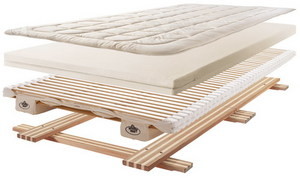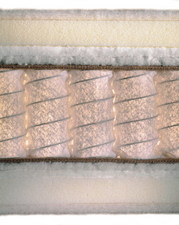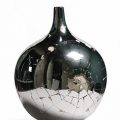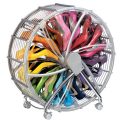 Which mattress to choose? All mattresses are divided intoorthopedic and "ordinary". WRONG. Strictly speaking, orthopedic mattresses are just the invention of cunning marketers. There are no GOSTs or other objective criteria for "orthopedicity". Another thing is that a correctly chosen mattress should support the spine in a relaxed position. Some models cope with this task better, others - worse (or do not cope at all). And it's not just a matter of construction or fillers. The most important thing is the anatomical features of a particular person, and they can be very different. Remember: no matter what the sellers say, even the best mattress cannot fix a deformed spine. But it will be an excellent preventive measure. Like a doctor, the main requirement is made to a mattress: “Do no harm!” Soft mattresses are more comfortable, and hard ones are more useful. WRONG. Convenience is a subjective concept. There are weirdos in the world who are comfortable sleeping on the floor! The idea of rigidity is also different for everyone. Therefore, it is more correct to talk about elasticity - the mattress should push the body, preventing the appearance of deep "cavities" in the shoulder and hip girdle. The main thing is not to overdo it. Sleeping on a bulletproof bed is harmful, it can disrupt blood circulation. However, the surface can be softened: put an additional (so-called thin) mattress on the main mattress, and enjoy comfort without harm to health. Each age category has its own mattress. TRUE. Mattresses with increased elasticity are recommended for children and adolescents - this will protect the growing spine from deformation. After 50, it stands with good anatomical properties - so that the mattress softly and carefully fits the body. Everyone else needs to find a middle ground. As they say, everyone - according to their needs! People with heavy weight need a special mattress. Such a mattress must be very elastic - otherwise it will sag under the weight of the body. Pay attention to the number of springs. It can range from 256 to 1,000 per sq. m. The more, the better the mattress will cope with physical activity. It is desirable that the springs are made of hardened steel - they have a high memory coefficient (when pressed, they tend to return to their original position - that is, straighten up). If the "users" of the bed belong to different weight categories, they need a combined mattress. CORRECT. A difference of 30 kg or more is considered critical. The easiest way is to put two different mattresses on the bed. But there are other options: you can order a common mattress with different hardness zones or buy a model made using the “spring in spring” technology (one of them is soft, the other is more elastic). With this design, everyone sleeps on "their" springs, so the mattress does not resonate and does not allow a person with a small weight to roll down to a heavier one. Good mattresses are made only from natural materials. WRONG. For example, there is a whole group of high-quality springless mattresses made of special heat-sensitive polymers - "memoriform", "memorix", etc. They take the shape of the body, reacting to its temperature. In nature, materials with similar properties simply do not exist.
Which mattress to choose? All mattresses are divided intoorthopedic and "ordinary". WRONG. Strictly speaking, orthopedic mattresses are just the invention of cunning marketers. There are no GOSTs or other objective criteria for "orthopedicity". Another thing is that a correctly chosen mattress should support the spine in a relaxed position. Some models cope with this task better, others - worse (or do not cope at all). And it's not just a matter of construction or fillers. The most important thing is the anatomical features of a particular person, and they can be very different. Remember: no matter what the sellers say, even the best mattress cannot fix a deformed spine. But it will be an excellent preventive measure. Like a doctor, the main requirement is made to a mattress: “Do no harm!” Soft mattresses are more comfortable, and hard ones are more useful. WRONG. Convenience is a subjective concept. There are weirdos in the world who are comfortable sleeping on the floor! The idea of rigidity is also different for everyone. Therefore, it is more correct to talk about elasticity - the mattress should push the body, preventing the appearance of deep "cavities" in the shoulder and hip girdle. The main thing is not to overdo it. Sleeping on a bulletproof bed is harmful, it can disrupt blood circulation. However, the surface can be softened: put an additional (so-called thin) mattress on the main mattress, and enjoy comfort without harm to health. Each age category has its own mattress. TRUE. Mattresses with increased elasticity are recommended for children and adolescents - this will protect the growing spine from deformation. After 50, it stands with good anatomical properties - so that the mattress softly and carefully fits the body. Everyone else needs to find a middle ground. As they say, everyone - according to their needs! People with heavy weight need a special mattress. Such a mattress must be very elastic - otherwise it will sag under the weight of the body. Pay attention to the number of springs. It can range from 256 to 1,000 per sq. m. The more, the better the mattress will cope with physical activity. It is desirable that the springs are made of hardened steel - they have a high memory coefficient (when pressed, they tend to return to their original position - that is, straighten up). If the "users" of the bed belong to different weight categories, they need a combined mattress. CORRECT. A difference of 30 kg or more is considered critical. The easiest way is to put two different mattresses on the bed. But there are other options: you can order a common mattress with different hardness zones or buy a model made using the “spring in spring” technology (one of them is soft, the other is more elastic). With this design, everyone sleeps on "their" springs, so the mattress does not resonate and does not allow a person with a small weight to roll down to a heavier one. Good mattresses are made only from natural materials. WRONG. For example, there is a whole group of high-quality springless mattresses made of special heat-sensitive polymers - "memoriform", "memorix", etc. They take the shape of the body, reacting to its temperature. In nature, materials with similar properties simply do not exist. Mattresses with dependent spring blocks -morally outdated. RIGHT. The dependent springs are intertwined: when you press one of them, the entire block sags. There is a hammock effect that is harmful to the spine. Such mattresses are practically not found among leading manufacturers, and more democratic factories are gradually switching to mattresses with independent springs. They are arranged differently: each spring is packed in a separate case, when pressed, it bends autonomously from its "neighbors". Biconical springs work in a similar way (they narrow towards the center and expand again towards the bottom), but they have one feature: they move not only up and down, but also left and right. Thanks to this, the mattress is elastic and soft at the same time. Natural latex is much better than artificial latex. WRONG. There are people for whom the choice of a natural product is a matter of principle, but from the point of view of consumer qualities, natural and artificial latex have much in common. They are hypoallergenic and elastic. It is the latex models that are recommended for beds with an electric base (with a motor and a system for adjusting the position of the body). When transformed, they repeat the bends of the base much more accurately than spring ones. Both types of latex absorb moisture equally well and evaporate it equally poorly. To combat this deficiency, special ventilation holes are made in mattresses. The properties of a spring mattress depend on its fillings. RIGHT. A good mattress uses several fillers at once, and each of them has its own role. Coconut coir gives rigidity, latex promotes elasticity, cotton fiber helps to maintain an ideal microclimate, sheep wool insulates, felt from jute and flax fibers increases service life, etc. It is on these layers (their combination, quantity, quality and thickness) that convenience depends this or that model. If the manufacturer is stingy with fillers, then the springs will dig into your sides. What comfort is there! But that's not all. Market leaders take the concept of "healthy sleep" literally and season mattresses with various beneficial substances. For example, the Treca brand uses in its models a silver thread to polarize cells and naturally "calm" the body, impregnates soft fillers with chrysanthemum extract (for lavender (this is a well-known sedative) and lemongrass (for an antibacterial effect). To save time, money and effort, you can buy a mattress through the Internet WRONG. You cannot save on health. On the Internet you can study the pricing policy of different brands, find expert recommendations and comparative characteristics of different models. But nothing more. A good mattress that suits you personally can only be chosen empirically: come to the store and lie on it for 10-15 minutes. A couple of years ago this was a problem, but now the sellers have become more accommodating. So, lie down - I don’t want to! The editors would like to thank Yulia Snopkova for help in preparing the material of the Neuhaus gallery.
Mattresses with dependent spring blocks -morally outdated. RIGHT. The dependent springs are intertwined: when you press one of them, the entire block sags. There is a hammock effect that is harmful to the spine. Such mattresses are practically not found among leading manufacturers, and more democratic factories are gradually switching to mattresses with independent springs. They are arranged differently: each spring is packed in a separate case, when pressed, it bends autonomously from its "neighbors". Biconical springs work in a similar way (they narrow towards the center and expand again towards the bottom), but they have one feature: they move not only up and down, but also left and right. Thanks to this, the mattress is elastic and soft at the same time. Natural latex is much better than artificial latex. WRONG. There are people for whom the choice of a natural product is a matter of principle, but from the point of view of consumer qualities, natural and artificial latex have much in common. They are hypoallergenic and elastic. It is the latex models that are recommended for beds with an electric base (with a motor and a system for adjusting the position of the body). When transformed, they repeat the bends of the base much more accurately than spring ones. Both types of latex absorb moisture equally well and evaporate it equally poorly. To combat this deficiency, special ventilation holes are made in mattresses. The properties of a spring mattress depend on its fillings. RIGHT. A good mattress uses several fillers at once, and each of them has its own role. Coconut coir gives rigidity, latex promotes elasticity, cotton fiber helps to maintain an ideal microclimate, sheep wool insulates, felt from jute and flax fibers increases service life, etc. It is on these layers (their combination, quantity, quality and thickness) that convenience depends this or that model. If the manufacturer is stingy with fillers, then the springs will dig into your sides. What comfort is there! But that's not all. Market leaders take the concept of "healthy sleep" literally and season mattresses with various beneficial substances. For example, the Treca brand uses in its models a silver thread to polarize cells and naturally "calm" the body, impregnates soft fillers with chrysanthemum extract (for lavender (this is a well-known sedative) and lemongrass (for an antibacterial effect). To save time, money and effort, you can buy a mattress through the Internet WRONG. You cannot save on health. On the Internet you can study the pricing policy of different brands, find expert recommendations and comparative characteristics of different models. But nothing more. A good mattress that suits you personally can only be chosen empirically: come to the store and lie on it for 10-15 minutes. A couple of years ago this was a problem, but now the sellers have become more accommodating. So, lie down - I don’t want to! The editors would like to thank Yulia Snopkova for help in preparing the material of the Neuhaus gallery.

Making Money with Desserts: Success Stories
Yevhen Polishchuk (Fedutinov) instagram: @ evgeniyafedutinovavk.com / janeshomebaking– It all started with baking for relatives and friends. Gradually, she began uploading photos of her baking to Instagram, and orders began to come in. I made my first cake to order on October 13, 2014, and a little earlier I started making macarons and cupcakes. We can say that the business "found me myself", I am very [...]

Soups are cold recipes with photos
Cold cucumber soup with yogurt and lemonSorbet from La Taverna restaurant chef Alexander Zhurkina Photo: Getty Images Ingredients: Yoghurt without additives - 125 gCucumber - 150 gSorbet lemon / lime - 50 gCool shrimp - 24 gFresh ginger - 1 gLime lime - 5 gFresh orange juice - 5 gPetroshka - 1 g pink - 1 gCress salad - […]

barbeque kebab
Pork tenderloin glaze Photos: Dmitry Bayrak / dbstudio Cooking time: 20 minutes + time for pickling. Calorie content: 454 kcal per 1 serving. For 4 servings: 4 pork tenderloin (about 300 g each), 1 onion, 2 cloves of garlic, 1 tsp. lemon peel, 1 tsp. lemon juice, a pinch of ground cumin, coriander and turmeric, 1 tbsp. l vegetable [...]

Pierre Duacan: dietary recipes: Ducane diet
Beetroot Photo: Season'S, Luxury Hotels Representation You will need: · Boiled beets - 60 g · Fresh cucumbers - 20 g · Red radish - 20 g · Green onions - 10 g · Egg - 1 pcs · Mineral drinking water - 200 g · Salt - 1 g Ready: · Boil egg and beetroot. · Grind cucumbers, radishes and a part of beets. Putting everything [...]





